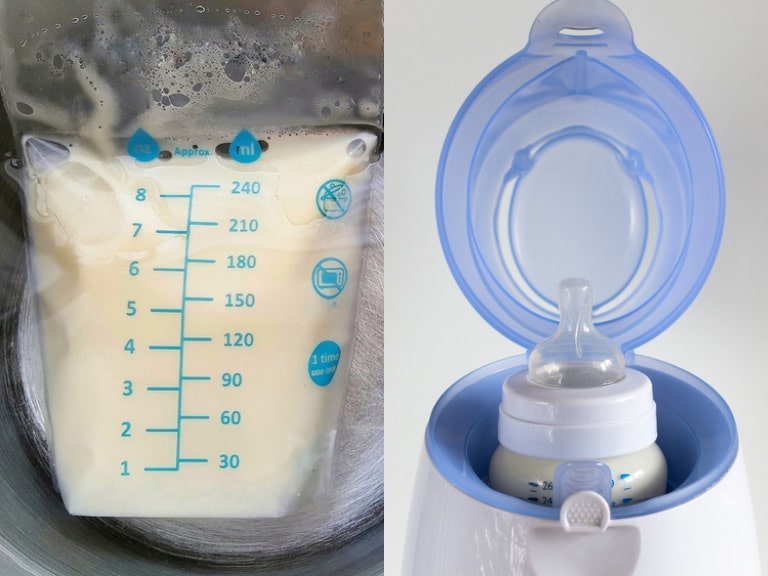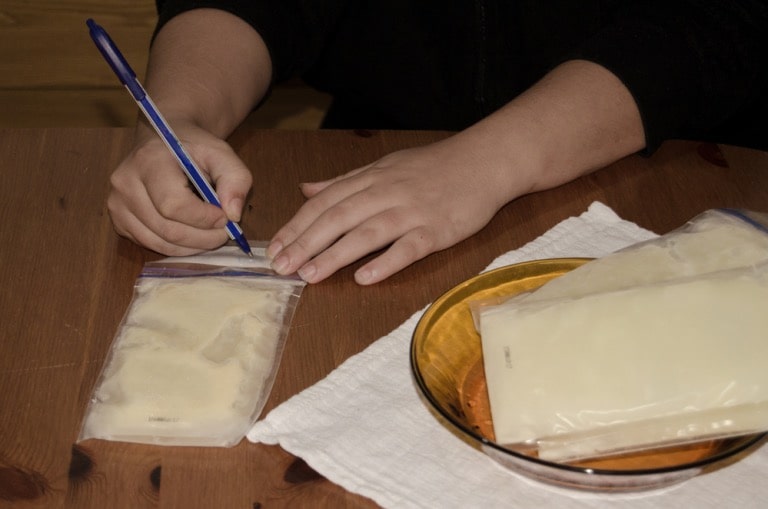As a working mom, you have to juggle between work and raising your infant. Fortunately, you can now pump and store your breast milk to ensure that your baby has enough milk to feed on while you are away for work or other important chores.
But how long can breast milk stay out after warming? This article offers you some useful tips on how to store your breast milk to prolong its shelf life.
How Long Can Breast Milk Stay Out After Warming?
To be on the safe side, you should start counting the 24 hours when your frozen breast milk is completely liquefied, not from the time you remove it from the freezer. Once you bring your breast milk to room temperature or warm it, it must be used within two hours.
If there is any leftover milk after feeding your baby, throw it away within two hours. You can’t refreeze your breastmilk after it thawing it.
The main reason why you should use your thawed breast milk as soon as possible is that bacteria start to grow more rapidly when the milk is warmed. Therefore, the longer it stays unused, the more dangerous it becomes to your baby. Also, when you are thawing your frozen breast milk, be sure to thaw the oldest one first.
Several factors determine how long breast milk can be stored, including the milk volume, temperature fluctuations in the fridge or freezer, room temperature when the milk is expressed, and sanitation of the storage area.
Also, you have to follow specific storage and preparation practices to maintain the quality of your expressed breast milk and for the sake of your baby’s health. There are different procedures for storing breast milk at different temperatures.
Also, you don’t have to warm your breast milk when feeding your baby. You can simply serve it at room temperature. But if you want to warm it, there are some important steps you have to follow. For instance, you have to keep the container completely sealed. You shouldn’t warm your breast milk directly on the cooker or in the microwave.
Instead, you should place the sealed container with breast milk into a bowl of warm water or just hold it under warm running water for two or three minutes.

While you warm your breast milk, keep testing its temperature to ensure that it doesn’t become too hot for your infant. Just put a few drops on your wrist to check its temperature. You should also swirl your warm breast milk thoroughly to synthesize the fat that may have separated.
Can I Put the Milk Back in the Fridge After Warming?
As mentioned above, you can’t refreeze your breast milk after thawing it. Also, you can’t put it in the fridge after warming it. However, if you want to reuse the bottle within the two-hour deadline, you can put it in the fridge, rewarm it, or just keep it at room temperature.
Refrigeration helps to slow down bacteria growth, but you should not exceed the two-hour limit for the safety of your baby.
It’s also important to note that “complete thawing” means that the milk doesn’t have any ice crystals. So, if still there are some ice crystals in your breast milk, CDC considers it safe to put it back in the freezer. But fully thawed breast milk should never be refrozen. It’s also important to add that the room temperature determined how quickly your breast milk becomes unsafe for your baby.
Can You Reheat Breast Milk More Than Once?
The simple answer is yes. You can reheat your breast milk, but only once. Studies have shown that it is unsafe to reheat breast milk that has been partially consumed more than once, since reheating it would extinguish the good bacteria and nutrients found in breast milk.
Also, you should make sure that the reheated breast milk is used within four hours since it will have bacteria from the baby’s mouth.
So, if your reheated breast milk remains unused for more than four hours, it should be discarded immediately. As mentioned above, reheating breast milk depends on several factors, including the way you store it and how long it stays out of the freezer.
When You Shouldn’t Reheat Your Breast Milk
While it is okay to reheat your breast milk, there are instances when you shouldn’t. For example, you shouldn’t reheat your breast milk when if it has been sitting outside for over half an hour or if it was partially consumed by your baby. Bad bacteria from the baby’s mouth may have already contaminated it, making it dangerous to consume.
If your breast milk is already ruined from improper storage or after leaving it outside for so long, don’t reheat or give it to your baby. The easiest way to know if breast milk has gone bad is through odor. Since breast milk loses its immunologic properties when it is reheated, you shouldn’t reheat yours repeatedly, especially if your baby is sick.
Instead, you should feed your baby with a fresh bottle of breast milk from the fridge. Make sure the fresh bottle of breast milk is properly heated before feeding your baby. Don’t reheat breast milk that had been previously frozen, because thawed breast milk only has very little amount of living immune cells, which prevents contamination.
Tips on How to Store Breast Milk
Storing, freezing, and feeding breast milk is quite easy if you follow the right procedures. Make sure you follow these simple rules and ensure you are doing it safely.
How to Store Fresh Breast Milk

Always follow the 4-4-6 Rule when storing your freshly expressed breast milk.
- Good for 4 hours at room temperature (77° F or colder)
- Good for 4 days in the fridge (40° F or colder)
- Good for 6 months in the freezer (up to one year is acceptable)
- Store in small raises (1-3 oz) to avoid wastage
- Store in BPA free storage bags or bottles
- Put a date on your milk storage container or bag indicating when it was expressed and the number of ounces
- When freezing your breast milk, lay the storage bags flat to create a nice, thin bag of frozen breast milk that is easy to store in your freezer
How to Store Thawed or Previously Frozen Breast Milk
For this type of breast milk, follow the 2-1-0 Rule. Note that the times itemized are from the time the breast milk was completely thawed, not the time it was removed from the freezer.
- Up to 2 hours at room temperature (77° F or colder)
- UP to 1 day (24 hours) in the refrigerator (40° F or colder)
- Zero time back in the freezer (never refreeze breast milk once you’ve thawed it fully)
Does your baby refuse to take thawed breast milk? Does your thawed breast milk smell or taste soapy? If so, it could have excess lipase, which breaks down more rapidly at colder temperatures. In that case, you should try to scald your breast milk before freezing it to remove the excess lipase. You should also reach out to an International Board of Lactation Consultant (IBCLC) examiner to create a plan that works for you.
What If You Have Excess Breast Milk?
If you’ve pumped too much breast milk at once and you don’t want to discard it, you should store it in a deep freezer. Breast milk can remain safe in a deep freezer for up to one year. If you do not have a deep freezer, you can donate it to a breast milk bank.
There are so many milk banks that have made it easy for women to donate stored breast milk. Alternatively, you can use excess breast milk to wash your baby. Breast milk is great for the baby’s skin.

